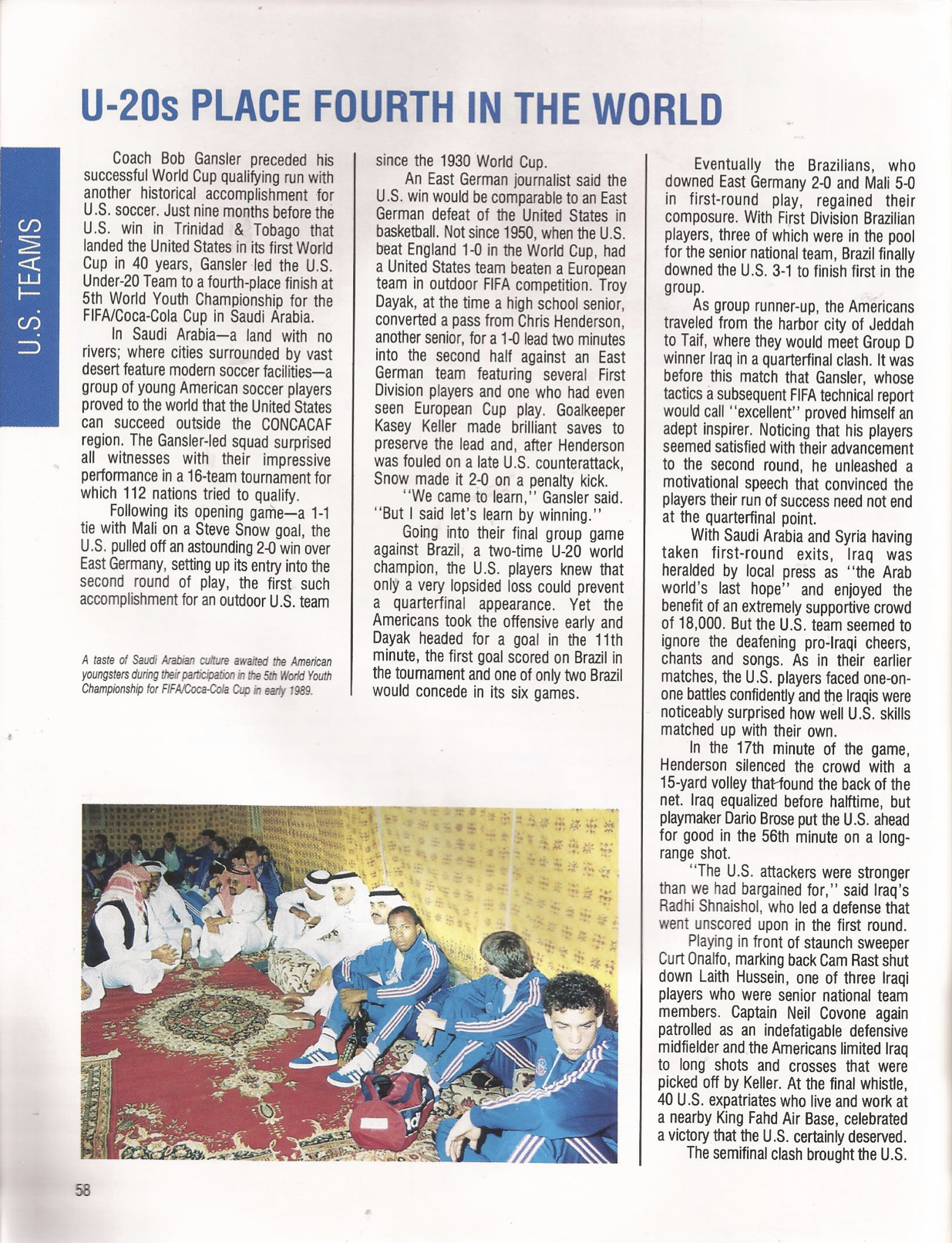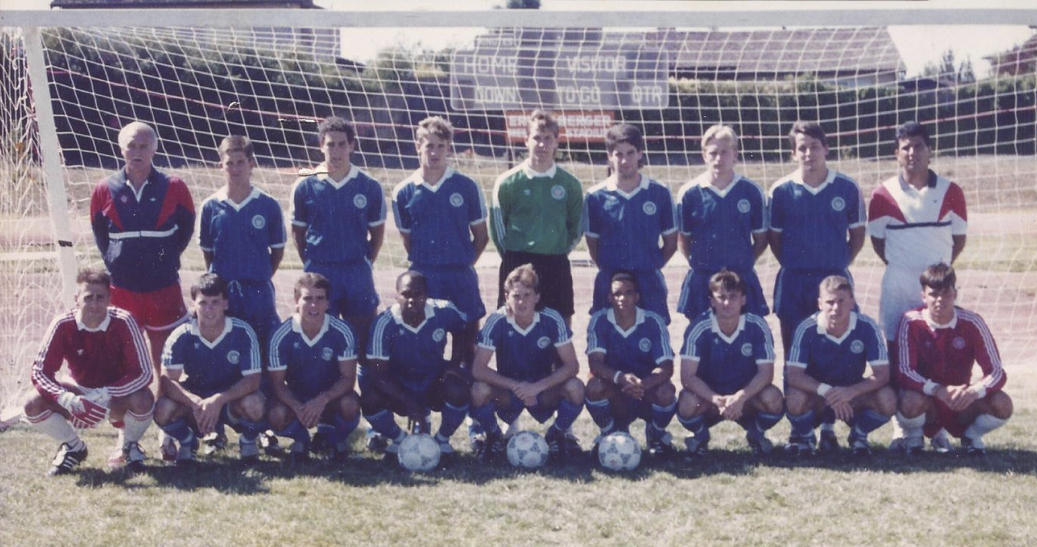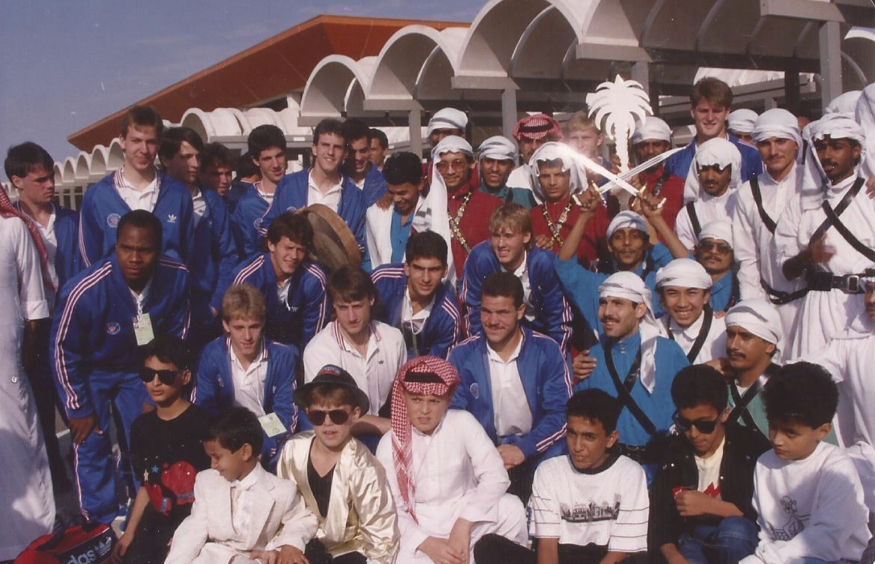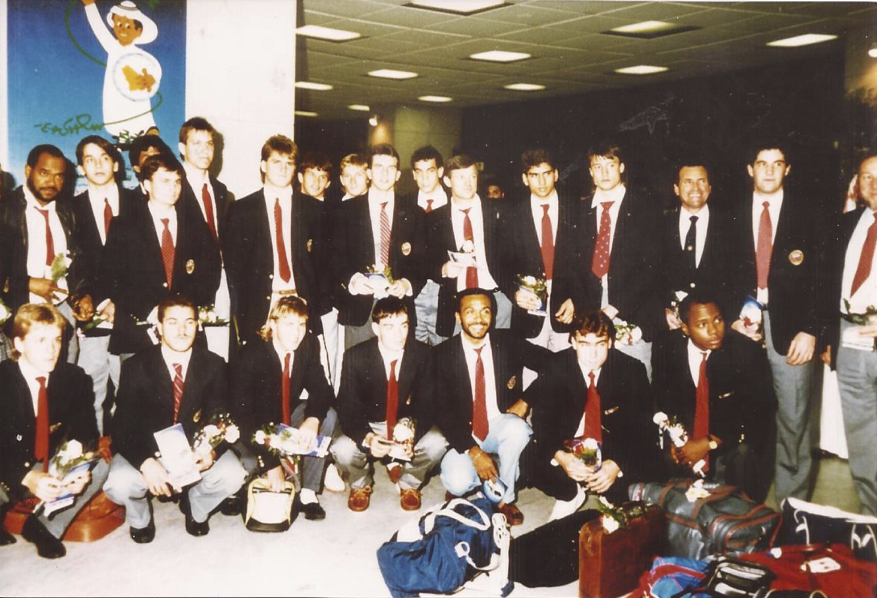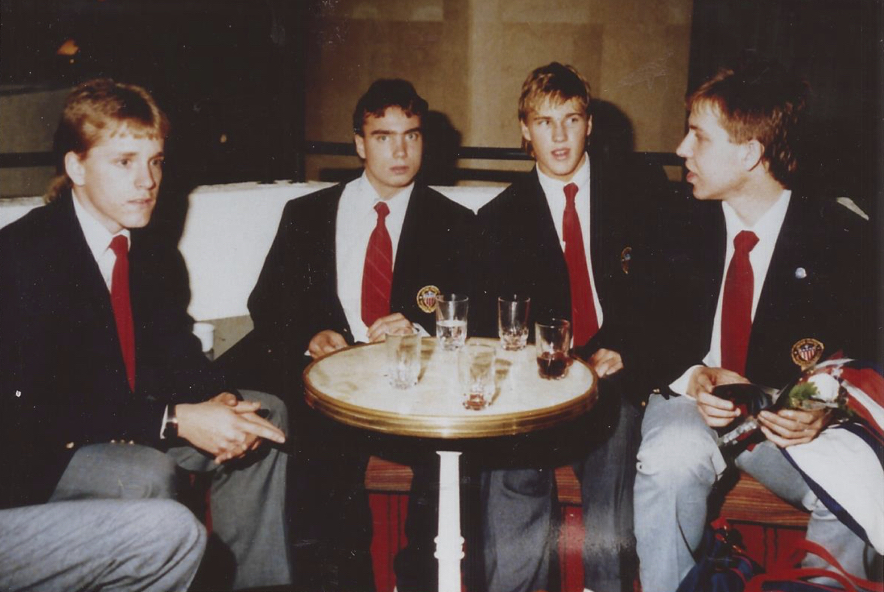A few years ago Everybody Soccer compiled a roundtable discussion aptly titled, Goalkeepers Discussing Goalkeepers. This year we return with a similar format but dive into the state of American goalkeeping prior to MLS's startup. Five goalkeepers with hundreds of collegiate and professional games from their career weigh in on the differences between the modern game to when they started playing.
Before you started playing professionally, who were goalkeepers you looked up to?
Peter Schmeichel, goalkeeper for Manchester United (1991-1999) and Denmark's National Team (1987-2001)
Mark Dodd (Duke University, FC Dallas): Well I think when I was really young, I’d probably have to say Peter Shilton. He just seemed like he was really “the guy” for England and seemed to have the whole game together. Then after that, I liked Toni Schumacher from Germany. He was such a big personality and just so dominate. Maybe technically not the same as Shilton but just such a dominant figure. And really I guess if I had to rank one the highest, it’d have to be Peter Schmeichel. You talk about a guy who really had it all. He played at such a high level for such a long time and he seemed to come up with these magnificent saves year after year. He was pretty special.
I tried to have all the elements and all the aspects of the game down, whether it be the technical abilities of saves or crosses or reading the game or distribution. There wasn’t one goalkeeper I molded myself after, it was probably more so that I would take the best things from each one of them and try to incorporate that into my game and just make it my game from there.
Justin Bryant (Boreham Wood FC, Orlando Lions): The first goalkeeper I looked up to was Winston DuBose. I was a Tampa Bay Rowdies fan, and watched every game on TV and quite a few in person at Tampa Stadium. What stood out about him at first was his acrobatic shot-stopping. When I got a little older, and especially when he became a teammate, I came to appreciate more subtle and advanced aspects of his game, like his communication and distribution. He was also a dominant cross-catching machine. But in those early years, when I was a kid, it was all about the spectacular saves. Watching Winston made me want to run out into the backyard and start diving around - and that's usually what I did.
I also had a soft spot for Ray Clemence and Ubaldo Fillol. It was more difficult to see them play, this being long before the internet, but I saw Fillol for the first time in the 1978 World Cup Final, which was the first soccer game I watched from start to finish. I became a River Plate fan because of him. And although I wasn't a Liverpool fan, I loved watching Clemence play whenever I had the chance. I think what all three had in common was a presence in goal, a confidence they exuded through their body language. That was something I tried to emulate even as a kid.
Scott Garlick (Tampa Bay Mutiny, Colorado Rapids): I watched Toni Schumacher of Germany, Peter Shilton of England, and I had a poster of Jean-Marie Pfaff, Belgium’s great goalkeeper of the 70’s and 80’s. They were all amazing shot stoppers who imbued an amazing sense of confidence in their respective teams.
Mike Ammann (Kansas City Wizards, NY/NJ MetroStars): Before I became a pro I did the only thing I really could and that was watch video tapes. Yes VHS, I'm that old. *laughs* I didn't really become a goalkeeper until I was 13 as I was too busy trying to score goals. My brother Bob was a goalkeeper so I can say I learned about the position through watching him play games. But it wasn't like I was studying the position back then. My brother and I had a highlight tape of the 1986 World Cup in Mexico. It showed goals and saves and it was something that would always get me fired up about playing in goal as it was around the time I started playing. Walter Zenga, Jean-Marie Pfaff, Pat Jennings, Zubizarreta, Toni Schumacher and Peter Shilton were the top goalkeepers that I enjoyed watching at that time. All had different traits and skills but all in their own way inspired me. We had an instructional video of Peter Shilton that I must have watched 1000 times.
Michel Preud'homme, Belgium National Team goalkeeper 1979-1994
Kevin Hartman (UCLA, LA Galaxy): As I grew up, there were quite a few goalkeepers that I admired. Usually they had a presence that drew me in and the effectiveness of their play made me continue to follow them. Goalkeepers such as Peter Schmeichel, Harald Schumacher, and Michel Preud'homme were the goalkeepers in Europe that I tended to follow the most. They were technically astute, fearless and demanded the respect of everyone in a stadium. In Central and South America, I was intrigued by Jorge Campos, Rene Higuita, and Faryd Mondragon. I knew that the future of goalkeeping involved playing off the line at moments and those keepers understood the game as well as most field players. I appreciated that and the shortcuts that they were able to access with that knowledge. We were also in a golden age of goalkeeping in the United States, when there was a real sense of pride about where our goalkeepers stood in relation to the world’s best. Keepers such as David Vanole, Kasey Keller, Brad Friedel, and Tony Meola provided a technical blueprint of what American Goalkeepers were about.
Who was the first goalkeeper coach that really opened your eyes to the position?
Bryant: I came of age as a player before goalkeeper coaches were common. At Radford University, we had Don Staley, who had been a goalkeeper himself. The best thing Don did was give the Radford goalkeepers a sense of identity, a pride in simply being a goalkeeper. Mark Dillon, the Orlando Lions manager, was not a goalkeeper coach, but he knew a great deal about the position, and made me think of it more in terms of helping your team, rather than playing for yourself.
The first real goalkeeper coach I had was one of the very best, Alex Welsh. When I was at Borehamwood FC, Alex invited me into the small group of London-based professional goalkeepers he trained. I was usually in a group with Paul Heald of Leyton Orient (later Wimbledon) and Tony Parks of Spurs. Our sessions were irregular - whenever all of us had a free morning or afternoon. Alex trained us at the Douglas Eyre Sports Centre in Walthamstow, North London. I had probably fewer than a dozen sessions with him in total, but he completely changed the way I thought about the position.
Alex, I believe, had learned primarily from the former Arsenal goalkeeper Bob Wilson. His sessions were the first time anybody had ever instructed me technically, regarding proper footwork, set position, hand position, etc. But what really opened my eyes was Alex's approach to the goalkeeper's mental and tactical preparation. He stressed that a goalkeeper's job was to reduce or eliminate the opponent's chances to score before a shot was taken, primarily through proper communication. I should also mention the player-manager I had at Borehamwood, Harry Meikle, who played as a center back and absolutely demanded that I communicate constantly throughout every game. It quickly became second nature.
Phil Parkes
Garlick: The first true goalkeeper coach was Phil Parkes, formerly of West Ham, Ipswich and QPR, who I met at a soccer camp growing up and who remains a friend to this day. I also had some non-goalkeeper specific coaches such as Luis Dabo, who helped me at an early age. The true soccer coach focused on technique, angles, and starting position, which will never change.
Ammann: I had the luxury of having my brother come to Cal State Fullerton and coach me my sophomore year following his professional career. Having a dedicated goalkeeper coach is essential as they are not just providing training but the constant reminders of your technique. Having a former pro who understands the little things that make a big difference and doesn't allow you to get into bad habits was critical to my growth during college. During college I also met Zak Abdel who had arrived from Egypt. Zak was fantastic to work with even though I was never more tired or sore than after one of his sessions. He put power into my game. He focused on being brave, aggressive and explosive. Every session was a challenge and between my brother and Zak they prepared me for life at the next level.
At the professional level I had 2 goalkeeper coaches that were influential for me, Alan Mayer and Phil Wheddon. Alan was not just a coach, he was a friend, father figure, and mentor. He was such a good athlete and worked with me in a racquetball court, tennis court, boxing, and the gym to become more athletic in my movement and footwork. He was extremely committed to helping the goalkeepers and was fun to work with. Unfortunately I didn't have more time to spend with Phil. Phil was a master at planning training sessions around what you needed and always had us sharp. I had the luxury of playing with a young Tim Howard at the time and we could not have been more different goalkeepers/athletes. Tim was just slightly more athletic than me *laughs* and you would think that would be a challenge for Phil to tailor sessions to meet both of our requirements. He was the master of it. I was more about positioning, organizing and reading the game. If I tried to play the same way Tim did or if Phil coached me the same as him I would have failed. He could work on the same topic but have different coaching points for each of us. He was extremely creative and taught me a lot about preparation and being ready to play.
Hartman: When I first started playing the position around 12 years of age, I was hooked. I sought out specialized training and it was not easy to come by in Southwest Virginia. I learned that Dr. Joe Machnik’s No. 1 Goalkeeper Camp would come through my area once a summer, and I lived for that brief five day period. The coaches were inspirational and pushed me to new levels. The curriculum of the camp was well laid out and addressed everything from proper techniques to the tactical situations in which they would be used. I owe a lot to that staff and the lessons that occurred both on the field and in the classroom.
When I moved to California, I had the opportunity to train with David Vanole, one of our Olympic and National Team goalkeepers at that time, regularly. He enjoyed the game as much as any human that I’ve seen play. He was larger than life, passionate, and was able to get so much out of the other players on the field, I wanted to understand how he was able to do it. Whether it was a compliment, a sarcastic quip, or an emphatic shout, he knew the buttons to push for every player that he worked with.
Dodd: I would probably say that guy would have to be Eric Vaughter. Eric was my goalkeeper coach at Duke. I was fortunate that I had a lot of head coaches that happened to be former goalkeepers so I got a lot of the fundamentals down. I had a lot of guys give me the basics for sure. But when I got to college, Eric was really somebody that was more than a coach. He was more a mentor and is still now a close friend. He just really instilled in me, I guess if nothing else, [the mentality of] “you’re the last line here and you have to take charge.” He really got us to embrace that so that when the game was on the line, and as I got later on in my career, I wanted that responsibility. He also really taught me how to work. I mean, hard. It was tough. He really pushed us to a level that *laughs* I’m not sure you could do in college anymore.
What is the difference in goalkeeper training from when you first started compared to now?
Garlick: There is a lot more thought in it now, which I am not sure is so great. I think sometimes we are turning goalkeepers into “robots” a bit, when the truly great ones play the position by a combination of technique, tactics and instinct. In other words, we have improved training “drills” over the last 30+ years, yet Gordon Banks, Peter Shilton, Schumacher, Pfaff, could all play today, assuming they worked on their feet some.
The position is about being a backstop to the team, now infused with the ability to be good with your feet, a leader, and someone who can begin the offensive portion of your team’s game. Goalkeepers now seem to be getting physically bigger, with an emphasis on making the spectacular save.
Ammann: How has goalkeeper coaching sessions changed since I played is a great question and I think you will get many different answers. The beauty of goalkeeping is that there is no ideal as much as people want to think there is. In your mind you can wish for a goalkeeper that is 6'4, powerful, fast, agile, great with both feet, a leader, communicator, calm presence, great teammate, great in training, off the field leader, etc etc. Well good luck finding it. Goalkeepers come in all shapes and sizes with various skill sets. That to me is why it's so great.
The best goalkeepers I have seen and coached are the ones that are the best athletes. I encourage kids to play multiple sports for as long as possible. Playing basketball, volleyball, lacrosse, tennis, jumping on a trampoline in your backyard, anything at all is going to help you become a better goalkeeper. Kids with hand-eye coordination and core strength and balance are always going to have a shot at being successful goalkeepers.
How other sports help you as a goalkeeper in my eyes:
- Basketball - hand-eye coordination, court awareness, footwork
- Volleyball - timing for high balls, footwork, quickness
- Lacrosse - communication and organizing players to mark up, stamina, footwork and hand-eye coordination
- Tennis - footwork, agility, and hand-eye
- Trampoline - core strength, balance, and agility
I don't think any one sport is going to hurt your abilities to become a better goalkeeper. I don't agree that you need to specialize in a position or sport until it's time for college. You can argue that the best goalkeepers the US has produced in years past were multi-sport athletes. The US has been the leader in producing goalkeepers on a global level and that is because of the variety of sports we play growing up. I'd hate to see us get away from that and I personally encourage parents to allow their kids to enjoy as many sports as possible to avoid burnout but to also allow their child to figure out what their best sport or most favorite sport and position is.
Hartman: When I began playing goalkeeper in 1984, goalkeeper training was in its infancy. The resources were few and far between. I was happy to have been able to find a few books at the library! At that time, America’s youth were playing multiple sports and many of those involved hand-eye coordination. Our youth had a head start over goalkeepers from many different countries based on the fact that we were playing baseball, basketball, and football.
American goalkeepers also reaped the benefit of a number of prominent goalkeeper camps looking to find a leg up in a competitive niche market. The lengths of the days got longer as each camp wanted to be the one that offered more hours, the quality of the special guests rose, but the revamped quality of the goalkeeping information was transformative. Many nuanced approaches from top European academies were introduced to young American goalkeepers in the early and mid 80’s. The elite goalkeepers that found themselves with a special coach, were well positioned for a long run professionally.
US goalkeeping thrived in that era, as well. Goalkeepers such as Kasey Keller and Brad Friedel became heroes in the Premiership. We have struggled to relay the lessons from generation to generation within US goalkeeping. The lack of any national goalkeeping direction since 2007 has left our country in a position where we are hoping that Tim Howard, who is now 38, can stick around for another World Cup. A country that was once regarded as the best country in the world at producing goalkeepers is losing our position. In a domestic league that once scoffed at the idea of going abroad to search out a more highly paid goalkeeper now sees that as a necessary solution. Both Atlanta United and Minnesota United went international as they began developing their goalkeeping corps. That speaks directly to the current state of domestic goalkeeping.
With that said, the expertise to change our course exists. The game has evolved and goalkeepers must be trained differently, by a coach with relatable experiences. Many similar lessons must be relayed, but the process is much more dynamic. With periodization, GPS, and heart rate monitoring, the coaches have adapted to working hand-in-hand with the physical conditioning experts. Training itself is more refined. From a technical warm-up to a scenario-based exercise to match play, the flow is more seamless. Vision training, cross training, and goalkeeper-specific plyometrics are a part of every top keeper's regimen. Goalkeepers spend much more time playing with the ball at their feet and nutritionists have now not only nixed many of the post-game libations, but defined the focus of preparation and performance in new ways. As the game develops further, the need for additional collaboration between the head coach and the goalkeeper coach, in terms of more of a total team training concept, increases. When I started playing the position, I trained alone with my coach, and more and more moving forward, that the coach and goalkeeper and team will train together.
Dodd: I think it’s evolved. I wouldn’t say it’s drastically different but there are areas that have evolved, just like the game has. But I would have to say that really in years past, goalkeepers spent a lot of time with ultra-high repetitions and things like that. What I think what we’ve realized now is that the goalkeeper’s position, why certainly you want to be in top shape, is about short bursts, agility, and quick movements. I never in a game probably ever had more than four saves in a row, quick back-to-back. I think now the focus is, and should be, on quality repetitions. Working on your quickness and explosiveness and agility, instead of ultra-high repetitions.
Bryant: Goalkeeper coaching became more common later in the 1980s. People like Joe Machnik and Tony DiCicco built companies around goalkeeper camps. I think the biggest difference between then and now is that now we try to make coaching much more game-realistic, whereas back then, the idea was training goalkeepers in a very high-volume, high-intensity workload. Lots of drills were designed to work the goalkeeper into exhaustion. That's something I've gotten away from, as I don't feel it reflects the demands of match-related actions, and puts the goalkeeper into a physiological state they are never in in matches.
Tony DiCicco pictured with Briana Scurry (Photo: Gina Ferazzi/Los Angeles Times)
Of course, goalkeeping itself has changed dramatically since the 1980s, primarily because of the back-pass law. So now we train goalkeepers to use their feet much more, and to be an integral part of playing out of the back. This means making sure they are comfortable not only playing passes, but receiving them under a degree of pressure. I train goalkeepers in isolation less than before. Now, I make sure that in addition to working with me as a group, they are integrated into team training with the outfield players. I'll never get away from coaching the primary responsibility of making saves, but the demands of the modern game mean they have to be able to play with their feet. And they have to train together with the back four, under game-realistic pressure, if they are going to defend effectively as a group.
Outside of having more goalkeeper coaches available, is there something you wish you had at your disposal that the modern goalkeeper has now?
Ammann: The biggest thing I wish I had when I was playing was access to video. Watching video of training sessions was not an option and we were lucky if we watched game footage. The video doesn't lie and for me, personally, that is how I learn. I'm a visual person and when someone tells me I'm diving backwards I may not understand it. But show me on a video that I'm diving backwards and it all makes sense and I can quickly make adjustments. I've used everything from iPhones, GoPro and even a drone in filming sessions that I coach now and they all are able to provide a different perspective to the player and most times instantly provide feedback.
Hartman: A crack at this expanded salary cap! *laughs* No seriously, as a goalkeeper, I always spent loads of time watching video. That usually entailed watching the game with a remote and a pad of paper. I’d jot down the times of important actions and then create for myself a video recording based off of those edits. It took forever! Today they have video editing programs that allow you so much more information with the click of a few buttons. I believe that if I had that technology back then, I’d have had enough time to have learned to play the guitar.
Dodd: From a standpoint of equipment, I wouldn’t say there is anything specific. I mean, believe it or not, the glove foams are virtually identical. In fact the boots and the cleats, the guys are going back to more of a traditional, especially goalkeepers. Six studs, no blades or fins or anything like that. They’re going back to more of the tried and true that works.
I think looking back in hindsight, I would have focused on different training aspects, different training elements. Worked more on some things that can simulate the game as much as possible. Having said that, I definitely think there have been a few significant changes in the position over the past 10 or 15 years. [One of the two changes] that stand out to me are, without a doubt, crosses. You just don’t see goalkeepers coming for near the amount of crosses that players had to in earlier days. Players are encouraged to put a lot more bend on the ball and make it more challenging for goalkeepers to come out. I also think that, like in any sport, players are getting bigger and taller, defenders are getting bigger and taller. So if your back line is full of guys who are 6’3”, you don’t need to come out for those crosses anymore. So I think it’s definitely shifted the goalkeeper position further back on the line.
The other thing that happened from my early days in MLS to now is through balls and breakaways. You rarely see, with the exception of Manuel Neuer or someone like that, goalkeepers coming off their line to beat them to the ball. It just doesn’t happen much anymore. As players get faster and physically quicker, your defenders and so forth, you have a higher amount of defenders with speed. It used to be that a number of defenders were positionally really sound and strong guys but now they want them to have a lot of speed as well. So that really negates some of through ball opportunities. I think the other thing that the goalkeepers have realized is that that’s a really risky proposition. When you’ve got a through ball or a 50-50 or whatever, and the goalkeeper has to come out and go down at a guy’s feet, he’s leaving his line. And if he’s even a split second off, that’s it. It’s a tap in.
This is a very subtle small thing that I’ve seen change, and it’s actually something that I was a proponent of, and certainly playing in Dallas where it was very dry. In England, the grass has a little moisture on it, whether it be rain or intentionally. They would try to get it where there was just enough skips on the ball to be played over the top so it doesn’t run away or it doesn’t check up. Playing in some dry conditions in the states, that’s something that would make the through balls all the more difficult. A guy would play a through ball, maybe with a little back spin or whatever, and not only did you have to factor the weight of that pass, the speed of that forward, and the timing, but what was it going to do off the ground? If you’re playing somewhere where it’s a little bit sticky grass and it checks up on you, huge advantage to the forward. Whereas now, the groundskeepers will put a little water on the field before the match, or at halftime, to have the right amount of skip and pace. I think that’s a good thing, it keeps it faster. But just things like that kind of evolve and keep the game evolving.
So in some ways, I think looking back, I think some of the more difficult things for the goalkeepers were having to time these crosses. I can’t remember, we used to keep a stat of catches and punches. I think I had some ungodly amount my first or second year [in MLS]. You know, 170, 190. That requires a really high level of timing and precision. Same thing with through balls and breakaways. So I think that was a little more challenging. I think in today’s game, goalkeepers are facing closer range shots. Specifically balls that get down the wings or players get in and take a defender on and pull the ball back across and you’re literally getting these point blank, quick taps, or flick headers. I think that’s definitely more challenging for the guys now. Having said that, I think that they’re almost coming a little more like hockey goalkeepers. You know, it’s very reactionary. Quick reflexes and agility are paramount. So you know, it’s not to say that one year was more difficult or more challenging. I think they all have their challenges. But the position is evolving.
Bryant: The main thing I wish we'd had back in the 80s-90s is the video technology goalkeepers have today. It is very easy to spot technical flaws these days: just stick a GoPro behind the goal and watch the footage in slow motion. I would have loved to have been able to do that. I think it would have made a real difference to my performance. It would have been great to have been able to watch my games on video, too, to analyze my decision-making, but almost nobody videoed games back then. I have just one full 90-minute game on video from my playing days.
I'm also envious of all the sports science and nutrition advances. We really didn't know anything about strength and agility training, eating for recovery, or the importance of diet and sleep to performance. I was fortunate to never suffer any serious injuries, but I could have benefited greatly from modern strength training. Finally, I'd have loved to have had lightweight, climate-specific performance fabrics, especially cold weather gear for my seasons in the UK.
Garlick: No, growing up in the age where using one's feet was important, this was a vital skill during an important transition in the modern game. Strength training specifically dedicated to goalkeeper movements would maybe be one thing I wish I would have had when I was playing.










